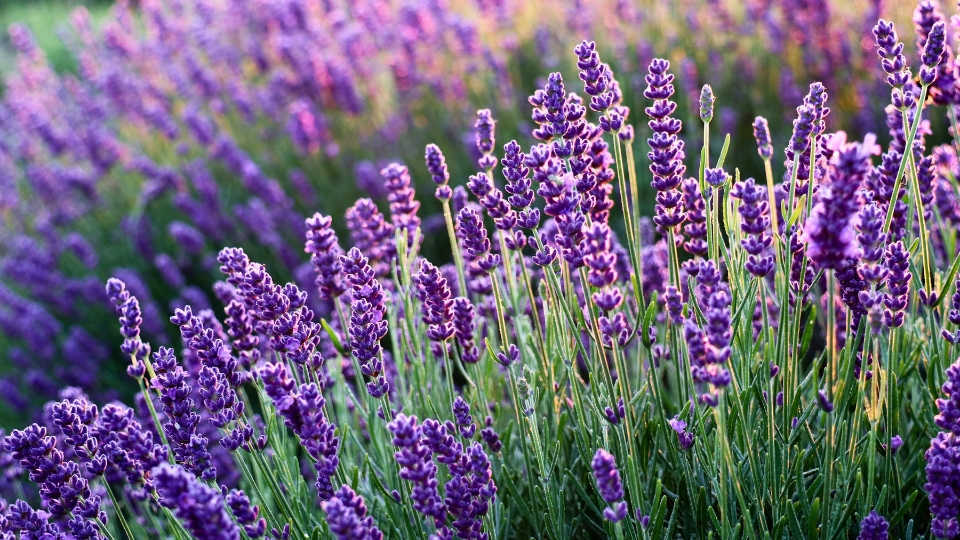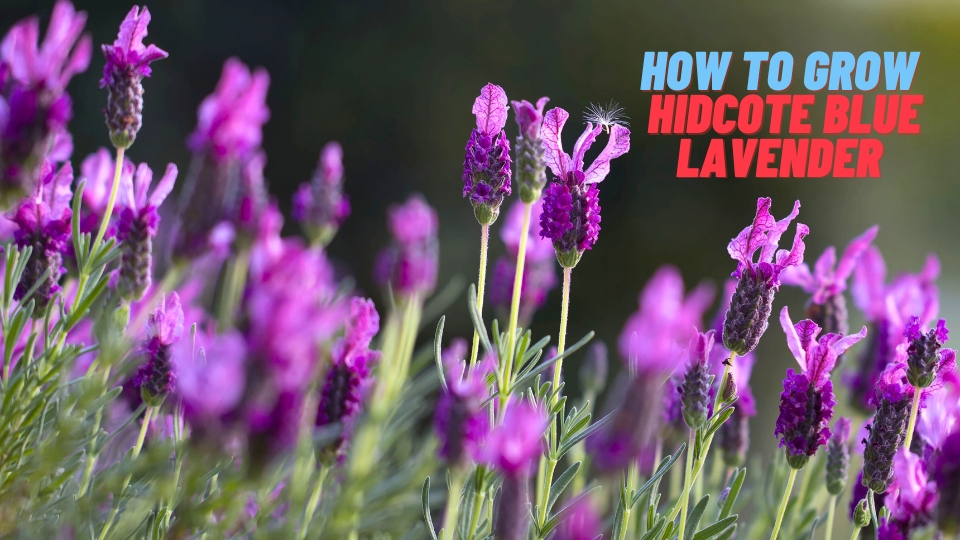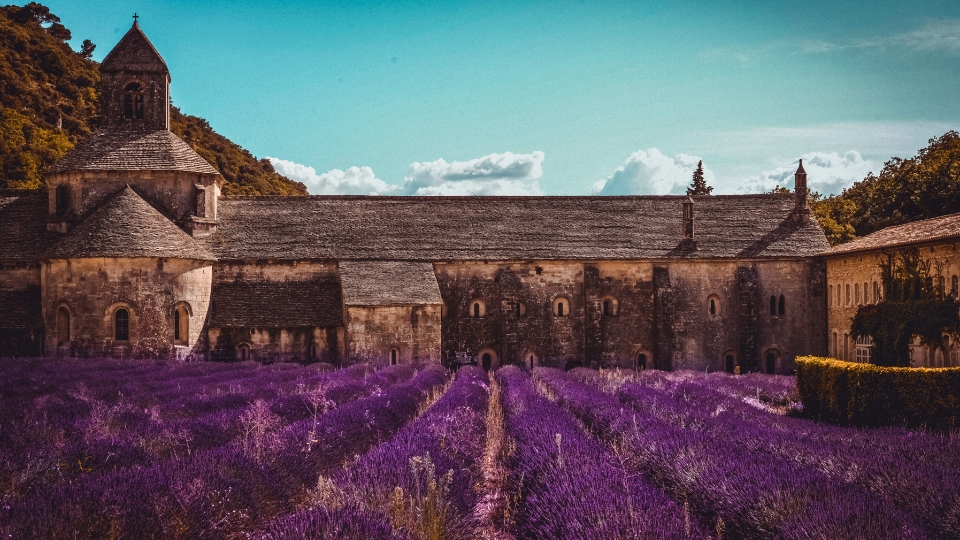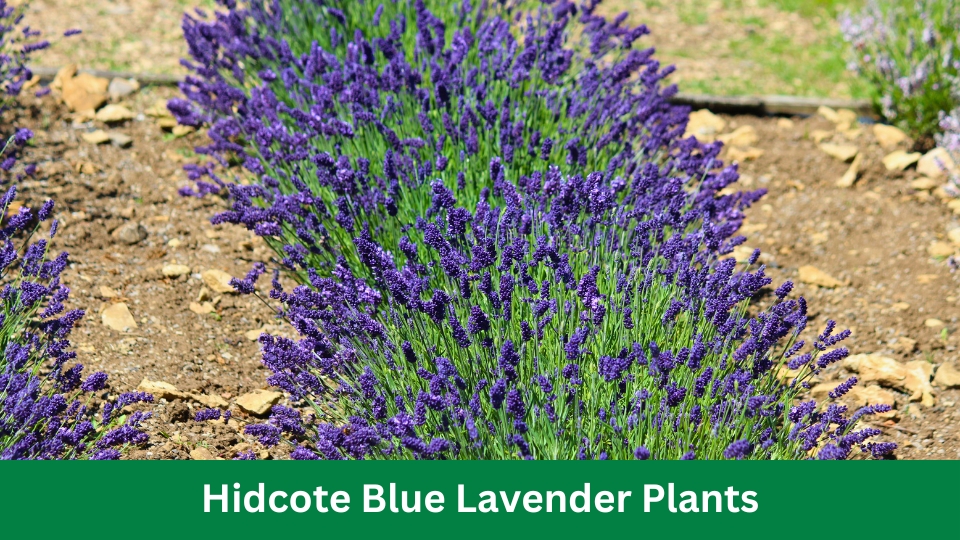Hidcote Blue Lavender plants are known for their deep purple flowers and aromatic fragrance. These plants thrive in well-drained soil and full sun, making them a perfect addition to any garden or landscape.
With their compact growth habit, Hidcote Blue Lavender plants are also suitable for container gardening. In addition to their beauty, these lavender plants are loved for their calming and soothing properties, making them a favorite among herbalists and aromatherapy enthusiasts.
Whether used as a decorative plant, culinary herb, or natural remedy, Hidcote Blue Lavender plants are a versatile and delightful addition to any outdoor space.
Characteristics Of Hidcote Blue Lavender
Hidcote Blue Lavender is a stunning and popular variety of lavender. It possesses several unique characteristics that set it apart from other lavender varieties.

In this section, we will explore the appearance and growth habits, fragrance and essential oil, and the benefits and uses of Hidcote Blue Lavender.
Appearance And Growth Habit
Hidcote Blue Lavender showcases a compact and bushy growth habit, making it a perfect addition to any garden or landscape. Its dense foliage forms a neat mound, reaching an average height of about 18–24 inches. The narrow, grey-green leaves provide an attractive backdrop for the vibrant purple-blue flowers that bloom from early to mid-summer.
With slender stems from the foliage, Hidcote Blue Lavender boasts an abundance of flower spikes measuring approximately 2–3 inches long. These spikes are topped with numerous aromatic flowers, creating a captivating display that adds visual appeal and attracts pollinators like bees and butterflies.
Fragrance And Essential Oil
The intoxicating fragrance of Hidcote Blue Lavender is one of its most standout characteristics. The air is filled with a delightful, calming, and uplifting scent when it is in bloom. This distinct aroma is pleasing to humans and is a natural repellent against unwanted insects.
Hidcote Blue Lavender is also highly prized for its essential oil derived from flower spikes through a steam distillation. This essential oil possesses numerous therapeutic properties, including calming and soothing effects. It is often used in aromatherapy, skincare products, and culinary preparations, adding a unique touch to various recipes.
Benefits And Uses
The benefits and uses of Hidcote Blue Lavender extend beyond its captivating appearance and delightful fragrance. Here are some of the ways this lavender variety can be utilized:
- 1. Aromatherapy: Hidcote Blue Lavender essential oil can be used in diffusers, baths, or massage oils to promote relaxation, reduce stress, and improve sleep quality.
- 2. Culinary applications: The flowers and leaves of Hidcote Blue Lavender can be incorporated into various culinary creations, adding a distinctive flavor and aroma to dishes like desserts, teas, and syrups.
- 3. Medicinal properties: The essential oil of Hidcote Blue Lavender has been traditionally used for its antiseptic, anti-inflammatory, and analgesic properties, making it a valuable addition to natural remedies and skincare products.
- 4. Ornamental purpose: With its striking flowers and compact growth habit, Hidcote Blue Lavender is often used as an ornamental plant in gardens, borders, or containers, adding beauty and charm to any outdoor space.
Overall, the characteristics of Hidcote Blue Lavender make it a versatile and beneficial plant that can be enjoyed for its aesthetic appeal, delightful fragrance, and various practical applications.
How To Grow Hidcote Blue Lavender
Lavender is a popular perennial plant known for its fragrant flowers and calming properties. Hidcote Blue Lavender is a specific variety with beautiful deep violet-blue flower spikes and silvery-grey foliage, making it a favorite among gardeners. If you’re considering growing Hidcote Blue Lavender in your garden, here’s a guide to help you get started.
Soil And Sunlight Requirements
For optimal growth, Hidcote Blue Lavender needs well-draining soil that is slightly alkaline. It prefers sandy or loamy soil rich in organic matter. It’s important to ensure the soil is not overly wet, as lavender is susceptible to root rot.

Position your lavender plants in an area that receives full sun, as they require at least six hours of direct sunlight daily to thrive.
Planting And Propagation
When planting Hidcote Blue Lavender, start by preparing the soil. Remove any weeds or grass from the area and loosen the soil to a depth of around 12 inches. It’s recommended that the soil be amended with compost or well-rotted manure to improve its fertility and drainage.
Next, dig a hole slightly larger than the lavender’s root ball and place the plant in the hole, ensuring the top of the root ball is level with the soil surface. To ensure good root-to-soil contact, fill the hole with soil and gently tamp it down. Water the plant thoroughly after planting.
Propagation of Hidcote Blue Lavender is typically done through cuttings. In early spring, take cuttings of semi-hardwood, around 3-4 inches in length, from established plants. Remove the lower leaves, leaving only a few at the top, and dip the cut end in the rooting hormone.
Plant the cuttings in well-draining potting soil and keep them in a warm location with indirect sunlight. Maintain the soil’s moisture level and wait for the cuttings to develop roots before transplanting them into larger containers or the garden.
Care And Maintenance
Proper care and maintenance are essential for the health and longevity of your Hidcote Blue Lavender plants. Here are a few tips to keep in mind:
- Watering: Lavender is drought-tolerant once established, and overwatering can lead to root rot. Therefore, it’s better to go underwater than overwater your plants. Allow the soil to dry out between waterings, and avoid overhead watering to prevent fungal diseases.
- Pruning: Regular pruning is important to maintain the plant’s shape and promote bushier growth. Trim the spent flowers and some foliage after the initial bloom in late spring or early summer. This will encourage the lavender to produce more flowers and prevent the plant from becoming leggy.
- Fertilizing: Lavender plants generally do not require heavy feeding. However, you can apply a balanced, slow-release fertilizer in spring to provide some nutrients. Avoid using high-nitrogen fertilizers, as they can promote excessive leaf growth at the expense of flower production.
- Pest and Disease Control: Hidcote Blue Lavender is relatively resistant to pests and diseases. However, watching for common issues like aphids, spider mites, and fungal diseases would be best. Regularly inspect the plants and take appropriate action at the first sign of trouble.
By following these guidelines for soil preparation, planting, propagation, and care, you’ll be well on your way to growing thriving Hidcote Blue Lavender plants in your garden. Enjoy the beauty and fragrance this stunning lavender variety brings to your outdoor space.
Pruning And Harvesting
Hidcote Blue Lavender plants require proper pruning and careful harvesting to ensure optimal growth and maximize the yield of gorgeous lavender flowers. This section will explore the different pruning techniques for promoting healthy growth and the best practices for harvesting and drying lavender flowers.
Pruning Techniques For Optimal Growth
Proper pruning is essential to maintaining the health and shape of your Hidcote Blue Lavender plants. By following these pruning techniques, you can encourage healthy growth and abundant blooms:
- Prune in Spring: Start pruning your lavender plants in early spring once the threat of frost has passed. This will allow new growth to emerge without the risk of damage.
- Trim Dead and Damaged Stems: Carefully inspect your plants and remove any dead or damaged stems by cutting them back to the base. This will promote the growth of new, healthy stems.
- Shape the Plant: Prune about one-third of the plant’s height to maintain the desired shape and prevent your lavender from becoming too leggy. Trim the stems just above a set of leaves, ensuring a clean cut.
- Avoid Cutting into Old Wood: Be cautious not to cut into old wood when pruning your lavender. This can harm the plant and inhibit new growth. Focus on trimming the new growth near the top of the plant.
Harvesting And Drying Lavender Flowers
Once your Hidcote Blue Lavender plants bloom, it’s time to harvest their fragrant flowers. Follow these steps to ensure proper harvesting and drying:
- Pick at the Right Time: Harvest the lavender flowers when the buds have just opened but before they fully bloom. This is when the essential oils peak, providing the best fragrance.
- Use Clean, Sharp Scissors: Ensure your tools are clean and sharp before harvesting. This helps minimize damage to the plant and ensures a clean cut that promotes healthy regrowth.
- Choose Flowering Stems: Select the flowering stems with the most vibrant and colorful flowers. Avoid stems with wilted or faded blooms to maintain the highest quality lavender.
- Cut the Stems: Cut the lavender stems just above the leaves, using a diagonal cut to maximize surface area for drying. Bundle the harvested stems together with a rubber band or twine.
- Dry in a Dark, Well-Ventilated Area: Hang the bundled lavender stems upside down in a dark, well-ventilated area. This allows the flowers to dry naturally while preserving their color and fragrance.
- Store Properly: Once the lavender flowers are completely dry, remove the buds from the stems and store them in an airtight container. Keep the container in a cool, dark place to maintain the quality of the dried lavender.
By following these pruning techniques and harvesting practices, you can ensure the successful growth of your Hidcote Blue Lavender plants and enjoy the beauty and fragrance of their delightful blooms for years to come.
Hidcote Blue Lavender Plants: Common Pests And Diseases
Despite its hardy nature, Hidcote Blue Lavender plants can still be susceptible to a few common pests and diseases. In this section, we will discuss how to identify and prevent pests, as well as how to manage diseases effectively.
By being proactive in your garden care routine, you can ensure your Hidcote Blue Lavender plants stay healthy and vibrant all year round.
Identifying And Preventing Pests
Keeping a watchful eye on your Hidcote Blue Lavender plants is crucial for identifying and preventing pests. By early detection, you can take appropriate measures to control the infestation. Here are some common pests that can affect Hidcote Blue Lavender:
| Pest | Identification | Prevention |
|---|---|---|
| Aphids | Tiny green or black insects are found on the leaves or stems. | |
| Spider Mites | Small red or yellow mites are usually found on the undersides of leaves. | Regularly mist your lavender plants to increase humidity and discourage spider mites. Prune and discard heavily infected foliage. |
| Slugs and Snails | Slime trails or chewed leaves are signs of their presence. | Place slug traps or physical barriers like copper tape around your lavender plants. Remove any hiding spots, such as overgrown vegetation. |
Besides these pests, Hidcote Blue Lavender plants may occasionally attract other insects like whiteflies, scales, or thrips. It’s important to regularly inspect the foliage and take appropriate measures to prevent significant damage.
Maintaining a balanced ecosystem in your garden and ensuring favorable conditions for beneficial insects can go a long way in pest control.
Management Of Diseases
Diseases can weaken your Hidcote Blue Lavender plants and affect their overall growth. Understanding the signs and symptoms of diseases is crucial in effectively managing them. Here are some common diseases that can affect Hidcote Blue Lavender:
- Powdery Mildew
- Root Rot
- Lavender Wilt
Powdery Mildew appears as a white powdery substance on the leaves, while Root Rot causes wilted and discoloured foliage. Lavender Wilt is characterized by the drying of stems and overall decline of the plant. To manage these diseases:
- Ensure proper air circulation by avoiding overcrowding of plants.
- Water the plants at their base to prevent splashing water on the foliage, which can promote disease spread.
- Remove and destroy infected plant parts to prevent further spread.
Creative Uses Of Hidcote Blue Lavender
Hidcote Blue Lavender is not only a beautiful addition to any garden, but it also has various creative uses. From culinary applications to decorative and ornamental uses and even aromatherapy and relaxation, this versatile plant offers a range of possibilities. Let’s explore these creative uses in more detail:
Culinary Applications
Hidcote Blue Lavender can bring a unique twist to your culinary creations with its fragrant and slightly sweet flavor. Here are some ways to incorporate this delightful herb into your dishes:
- Infuse honey with Hidcote Blue Lavender to add a hint of floral sweetness to your tea, or drizzle it over desserts.
- Use the dried flowers to make lavender sugar, sprinkle it over baked goods, or use it in recipes that call for sugar.
- Add a sprinkle of fresh or dried Hidcote Blue Lavender flowers to salads or roasted vegetables for an aromatic and flavorful twist.
- Experiment with lavender-infused syrups or sauces to accompany savory dishes such as grilled meats or roasted vegetables.
Decorative And Ornamental Uses
The vibrant purple flowers and distinctive fragrance of Hidcote Blue Lavender make it an excellent choice for decorative and ornamental purposes. Here are a few ways to incorporate this plant into your garden or home:
- Plant Hidcote Blue Lavender in borders or flower beds to add color and attract pollinators like bees and butterflies.
- Create lavender wreaths or floral arrangements using the dried flowers for a charming and fragrant decoration.
- Place freshly cut Hidcote Blue Lavender stems in vases or jars to infuse your home with a soothing and pleasant scent.
- Combine the dried flowers with other botanicals to make potpourri or sachets that can be placed in closets or drawers for a natural and refreshing fragrance.
Aromatherapy And Relaxation
Hidcote Blue Lavender is widely known for its calming and relaxing properties. Here are some ways to incorporate this plant into your self-care routine:
- Create lavender essential oil by distilling the flowers and using it for aromatherapy. Add a few drops to a diffuser or mix it with carrier oils for a soothing massage oil.
- Make lavender-scented candles or bath products to help create a tranquil environment.
- Add dried Hidcote Blue Lavender flowers to homemade bath salts or bath bombs for a luxurious and aromatic soak.
- Place a small sachet filled with dried lavender flowers under your pillow to promote restful sleep and relaxation.
Whether in the kitchen, garden or for relaxation, Hidcote Blue Lavender offers a myriad of creative uses. Explore these ideas and let your imagination run wild with this versatile herb.
Hidcote Blue Lavender In Gardens And Landscapes
Discover the beauty of Hidcote Blue Lavender plants in gardens and landscapes. These stunning lavender plants add vibrant colors and a delightful fragrance to any outdoor space.
Lavender Gardens And Borders
Consider incorporating Hidcote Blue Lavender plants to create a serene and aromatic garden. These beautiful flowers are an excellent choice for creating lavender gardens and borders due to their stunning deep blue-purple blooms and ability to attract pollinators.
Hidcote Blue Lavender plants are known for their compact size, reaching about 1 to 2 feet. This makes them ideal for edging garden borders and creating clean, visually appealing landscapes. The dense foliage and vibrant purple flowers provide an enchanting backdrop to any garden, adding a touch of elegance and sophistication.
When planning your lavender garden or border, it’s important to consider the planting location. Hidcote Blue Lavender thrives in full sun and well-drained soil. Ensure the soil is loose and not overly rich, as excessive nutrients can hinder their growth. Additionally, space the plants about 12 to 18 inches apart to allow adequate air circulation.
Companion Planting With Lavender
Lavender is not only a beautiful addition to any garden, but it also offers several benefits when used as a companion plant. When planted near vegetables, herbs, or flowering plants, Hidcote Blue Lavender can help repel pests such as aphids, moths, and mosquitoes, thanks to its strong fragrance.
Including Hidcote Blue Lavender in your vegetable garden can also attract beneficial pollinators like bees and butterflies, helping to improve pollination and increase crop yield. Its ability to deter pests and attract pollinators makes it a valuable addition to any garden, promoting a thriving ecosystem.
Landscaping With Hidcote Blue Lavender
Hidcote Blue Lavender plants are perfect for gardens, borders, and larger landscaping projects. Their low-growing and compact nature makes them an excellent choice for creating low hedges or edging along pathways.
Their vibrant blue-purple flowers contrast beautifully with other plants and provide a striking visual appeal. To create a stunning and dynamic landscape design, consider planting them alongside ornamental grasses, roses, or other flowering perennials.
You can even incorporate Hidcote Blue Lavender into geometric patterns or knot gardens to create a more structured and formal look. Their neat growth habit lends itself well to these types of designs and adds an element of elegance to any landscape.
Hidcote Blue Lavender In History And Culture
Regarding fascinating plants, the Hidcote Blue Lavender stands out with its rich history and cultural significance. This section will explore the symbolism and cultural importance of this beloved lavender variety and the vibrant festivals and traditions that celebrate its beauty.
Symbolism And Cultural Significance
Lavender has been cherished for centuries for its enchanting fragrance and therapeutic properties. It symbolizes purity, serenity, and tranquillity – qualities that have made it an integral part of various cultures and societies.
Throughout history, lavender has been used for its medicinal benefits and was believed to possess magical properties. Its calming aroma made it a popular ingredient in perfumes, potpourris, and beauty products.

In addition to its practical uses, lavender holds symbolic significance in many cultures. It is often associated with love and devotion and was used in ancient rituals and ceremonies. The color blue, characteristic of the Hidcote Blue Lavender, represents loyalty and harmony, further enhancing the symbolism of this particular variety.
The Hidcote Blue Lavender, with its vibrant blue flowers and fragrant blooms, continues to be revered for its symbolic and cultural significance. Its timeless beauty has made it a beloved plant in gardens worldwide.
Lavender Festivals And Traditions
Each year, lavender enthusiasts come together to celebrate the beauty and versatility of this remarkable plant. Lavender festivals are held in various parts of the world, where visitors can immerse themselves in a sea of lavender fields and delight in the festivities.
During these festivals, attendees can participate in a range of activities, such as lavender picking, crafts, and culinary experiences. They can learn about the different varieties of lavender, including Hidcote Blue Lavender, and discover new ways to incorporate lavender into their daily lives.
Traditions associated with lavender vary across cultures. In Provence, France, the blooming of lavender fields is celebrated with traditional music, dances, and parades. In England, lavender is often used to create exquisite lavender wands, wall hangings, and sachets.
These festivals and traditions testify to lavender’s enduring popularity and cultural significance, particularly the Hidcote Blue variety. They provide a platform for lavender enthusiasts to unite, share their knowledge, and foster a deeper appreciation for this beautiful plant.
Frequently Asked Questions On Hidcote Blue Lavender Plants
How Big Does A Hidcote Blue Lavender Get?
Hidcote blue lavender can grow up to 24 inches in height. It is a compact variety with grey-green leaves and deep purple flowers.
Is Hidcote Lavender the best?
Hidcote lavender is known for its exceptional beauty and fragrance. It has a strong reputation for being one of the best lavender varieties due to its compact growth habit and vibrant purple flowers. Its aromatic scent and stunning blooms make it a top choice for gardeners and lavender enthusiasts.
Will Hidcote Lavender Survive Winter?
Yes, Hidcote lavender can survive the winter. It is a hardy plant that can withstand cold temperatures. Proper care and maintenance, such as pruning in the spring and providing well-drained soil, can help ensure its survival through winter.
Decision
To wrap up, Hidcote Blue Lavender plants are an excellent addition to any garden. Their stunning purple-blue flowers, fresh fragrance, and easy care requirements add beauty and serenity to outdoor spaces. Whether you’re a seasoned gardener or a beginner, these plants are a great choice.
Their versatility and resilience make them ideal for borders, containers, or even as a backdrop for other garden plants. So, introduce Hidcote Blue Lavender plants to your garden for elegance and tranquility.
Video Source And Information Ideas Link: https://www.youtube.com/watch?v=sUUNA3Ks87I



